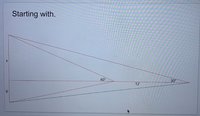aroberts5124
New member
- Joined
- Nov 7, 2020
- Messages
- 2
Hello, I have been trying to solve this all night. I think I have successfully solved the 30° angle. But I can not seem to get the 40° angle. We are only given the two angles. These are angles of elevation and depression. We also know the angles are from eye level and that is 6' above the ground. I am needing to figure out the total height. Also, we can not assume that there is a 90° angle even though it looks to be one, it could have a smaller angle. It is not to sale.


